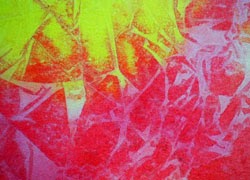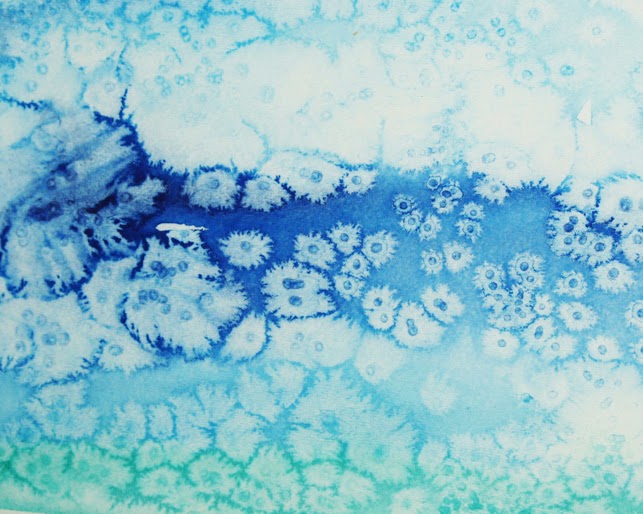Ever since I could remember, I would draw and paint. I was that little child kept alone at home, distracted with colour pencils and paints. It was all I needed, from childhood scribbles, to my work today. It all has been a gradual process of building technique with practice.
Here are few things I've learned over the years that might be of some help to you. Or not.
Say NO to boring white backgrounds
Bring out a new canvas, and all you see is white. A smart trick would be to use white gesso primer mixed with a hint of ocher or yellow to give the canvas a tint, or a light colour as a background. This gives a lovely tint to your canvas, and you might not even have to paint a background. Lazy artist, high five!
Sandpaper and its mighty effects
- When you use pencils, pastels or crayons to draw, constantly sharpening will lead to a lot of wastage! We all have that set of pencils that are too precious and expensive to just waste. Use sandpaper to sharpen the tips of the pencils and make most use of it.
- Sandpaper can also be used as textured paper for pastel work.
- Have you tried pressing sandpaper on a wet waterolour background? It gives wonderful texture and a some detail to your work
Grid it out!
For beginners or people who are having difficulty with drawing or replicating images, fret not! Just draw grids all over, and focus on sketching each square at a time. That way you won't find yourself with a wonky, or unbalanced image. Awesome stuff, right? Just try it out!
Pencil-tastic work!
Use an HB pencil to do your outlines. It is light, easily erasable and doesn't smudge very easily. Be smart and avoid harder pencils like 2H and 4H because that's going to leave an indentation on your paper, Yes I've learned this from experience, it's not pretty when you have dented lines on great art work. (All that ruined work)
Sketch it Black
Often when you're sketching and observing tones, you tend to go more grey than you do black even when it is black that you need. The dark portions of the art work are more shades of grey instead of black, it reduces the vibrance and intensity of your work. Imagine all your favourite clothes, fading from a jet black to a dull grey. Boring right? Simple solution: cut a piece of black paper from a scrapbook or a magazine, and use it to compare the areas that have to be black with it. Use an 8B pencil to achieve a similar shade.
Handy tip: Sometimes, I tend to use a thin brush and go over with light strokes of black paint.
Black & White
Instead of using a coloured reference photo, print it in black and white. Colours tend to distract you from tonality, lighting etc. that way you can observe the shades correctly
Sketch Journal
The best advice anyone ever gave me was to keep a sketch journal next to me at all times. Now, keeping the sketch journal isn't enough, you need to use it as well. Yes, if you're lazy like me, at first you're hardly going to use it, but TRUST ME, once you get started you won't stop. It doesn't have to be perfect and some of my work has been utter crap, but use it to draw. Draw what you see, draw what you feel, keep it near your bed and even draw what you remember from your dreams. We have heard the saying "practise makes perfect" a little too much, I know but trust me, it's true.
Patience is not always a virtue.
When it comes down to art, I have heard a lot of people say to me "I don't have that much patience" well, neither do I. If you're drawing, and don't have patience, spend on 15 minutes on it. Leave, start again another day. I like my work to take 30 minutes at most, which is why you'll notice a lot of it is incomplete. But it doesn't matter! Art is art, no matter how much time you take.
Brush Talk
Short, simple advice? Never, ever, EVER leave you brushes in the stand after you're done painting. The bristles will spread out and ruin them. (RIP brushes)
Hairy Tales
Hair is the most complicated thing ever, and over the years I have faced a lot of difficulty in perfecting hair. Bad hair can ruin a drawing, but great hair can save it! The most important thing to remember is direction. Make sure your strokes are not all one length, or one long bold stroke, but small lighter strokes in the direction the hair falls. FOCUS ON DIRECTION. Use a sharp tip of the eraser, and erase lightly in the direction the light falls to give highlights. Remember, if there is light on the subject, there will be areas of light on the hair as well. Once again, you just need to focus on the highlights and direction
Starting at the top...
I like to start my drawings/ paintings at the top, to avoid smudging it with my hand. I've learned the hard way, and trust me, it's happened way too
many times, the ill effects of my hand smudging my drawings and messing things up. If you want to start with the ears, or eyes or maybe even lowers on figure study (hint hint), then place a paper or clear sheet underneath where you hand touches the paper. You'll regret not doing this when you see grey smudges all over your paper.
Stand up, Sit Down, Walk Around. Work it out!
While painting, you tend to lose perspective if you stare at your work too long. Get up, walk around, take a break and return back to it for a fresher look. Also, try looking at your painting in the mirror to find things you may have missed out on in normal view. You could even check yourself out while doing so! Trust me it works!
Eyes!
They say it's all in the eyes, and I am restless until I have perfected the eyes on my portraits. After finishing painting or drawing the eyes, I love to add some white paint on to it, to make it pop a little bit more. Find the areas that are meant to be highlighted and dab some white paint onto there.
Texture Me UP!


- After a water wash on your water color paper, throw some watercolor pencil shavings on it for vibrant, stunning texture
- For wood textures, use a fan brush and lightly scrape across the paper
- Salt: Once you've applied a wash of colour on your paper, add some salt to it and let it dry. Scrape the salt off and check out that super cool texture!
- Get wrapped- After a wet wash, use wrapping paper or plastic wrap to lift paint of your canvas or paper and observe the effect!
Scribbling is fun


Finally, your art doesn't have to be perfect, it doesn't have to be great. Scribble your way to great artwork with simple strokes!
Enjoy and feel free to share some of your awesome work with me!
xoxo



















No comments :
Post a Comment
Leave a note :)